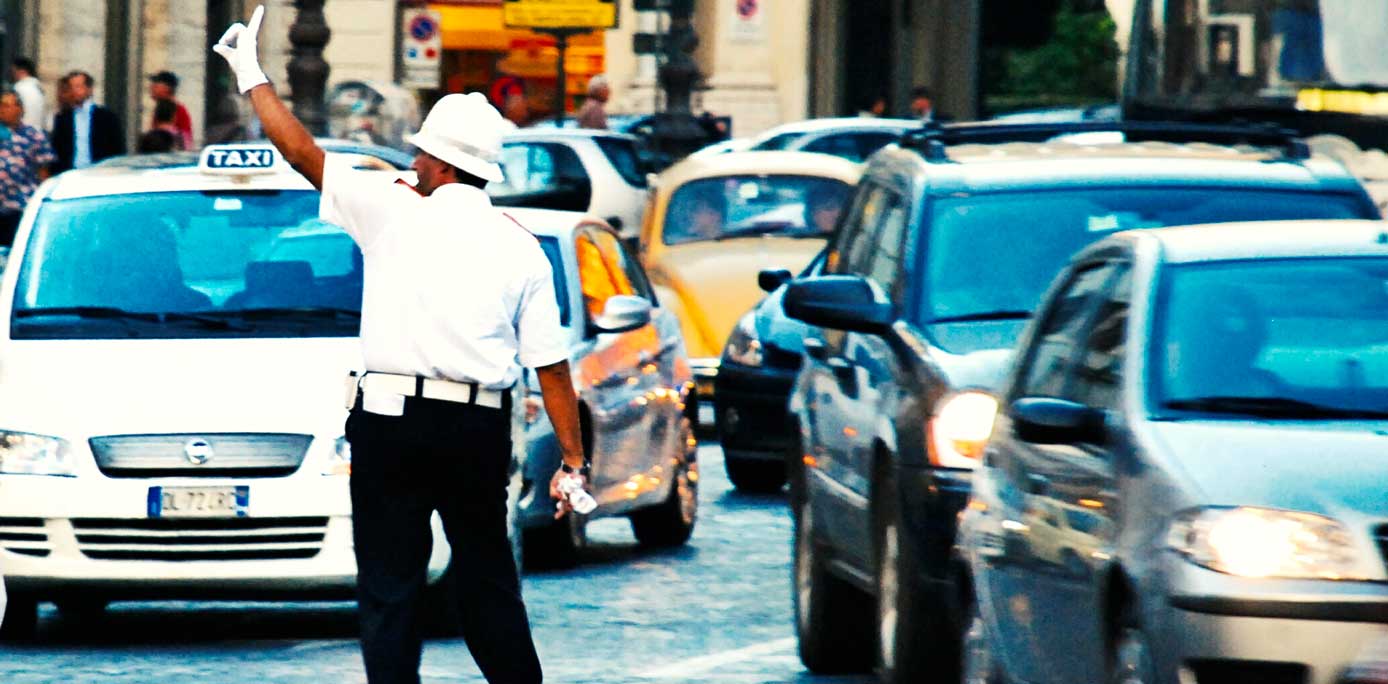Renting a car is easy enough. It’s all that comes afterwards that can create enough material for a good sit com! I still chuckle at the expression of horror on friends’ faces as I enthusiastically answer “Yes!!” when asked if I drive in Italy. After all, a stick shift in hand (automatics are hard to come by) and a full tank of benzina are the ticket to the delicious freedom of discovery for all that awaits down a winding Italian country road. However, any Mario Andretti wanna-be will be thankful to have a little pre-trip knowledge under the belt before putting the pedal to the metal.

There are any number of things Italy does well, and public transportation is one of these Pavel Kavalenkau | Dreamstime.com
Train or Car??
There are any number of things Italy does well, and public transportation is one of these. Trains and buses can easily transport to just about every major city and substantial sized town. Be kind to yourself — use them! Renting a car with the notion of taking a little sight-seeing tour “da solo” in Rome or Milan or Naples or even Florence is just not a good idea. Ever. A Tuscan friend tried to persuade me of this point some years ago, and after trying to navigate Florence – alone – no GPS – I know what I’m talking about.
Once you’ve seen the big city sites, it’s time to visit the rental car office. The picture postcard world of small villages, wineries, historic centers, and numerous other worthwhile sites become yours! Most rentals are now equipped with a GPS, making backroad traveling easy, but I do recommend an old-fashioned map be kept on hand. On one trip, a lilting Italian GPS voice kept insisting we drive down a staircase in Sicily. Probably not a great idea. I’ve been guided to proceed through a farmer’s gate more than once, as well. All that aside, one of the greatest joys experienced as a driver in Italy can be getting lost. So often it presents the memorable gift of a wonderfully unexpected experience!
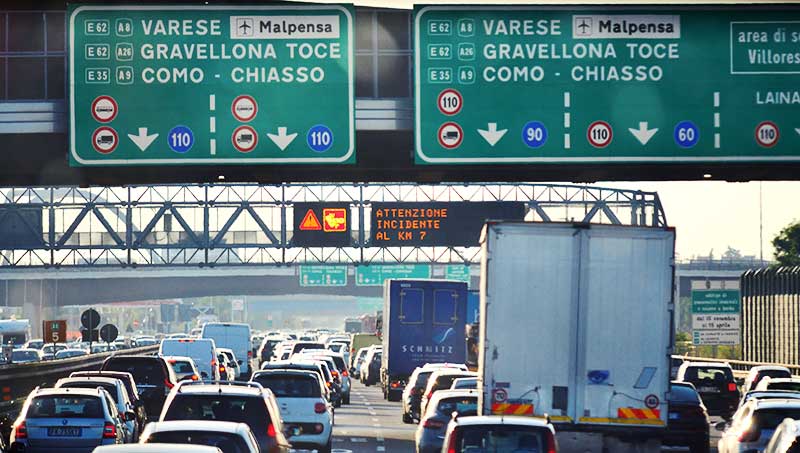
Germany has its Autobahn, Daytona has its 500, and Italy has its Autostrada
Italian Roads
Germany has its Autobahn, Daytona has its 500, and Italy has its Autostrada. These major six-lane speedways connect north to south, east to west via a (mostly) well maintained system of toll roads. Put your sensitivities behind you, get a steely grip on the wheel, and drive with the commitment of a 50-year marriage – and you’ll do just fine!
The basic rules of the road are fairly simple: stay in the far-right lane. Pass if you must but scurry back to the right or middle lane without delay. It’s a bit like a turf thing – the left lane is for the experienced Italian drivers who brush off a speed camera like a pesky fly on their pasta. The 130 km speed limit (81 mph) is a mere suggestion, as are painted lane markers, and you do not want to be in the way when a speed racer comes blowing through.
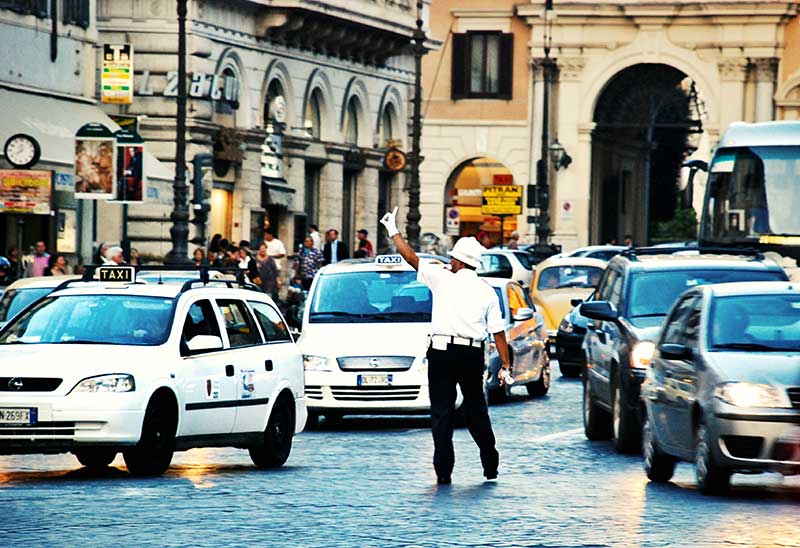
Travel comes with challenges, even frustrations, and that’s certainly applicable when choosing to drive in Italy
Which brings me to the “symbology” one might experience if not back in their lane quickly enough. Italian drivers are skilful, confident, and truly not aggressive as might be perceived. But the unspoken rules of the road are solid and they’re not timid about reminding you. Flashing headlights equate to move over…NOW. Riding a bumper so close that you can count the fillings in the driver’s teeth means the same. And those hand gestures? No explanation needed.
The “minor roads” are what most would consider the scenic route – small, winding two-way passages that meander through landscapes surely made from dreams. These are worth every white-knuckle Autostrada moment it might take to get to one! Don’t get too distracted by the beauty, however, as staying in one’s lane is also filed under “suggestioN.” It’s quite a common (and jolting) experience to round the next curve to find a Fiat coming full speed ahead…in your lane.
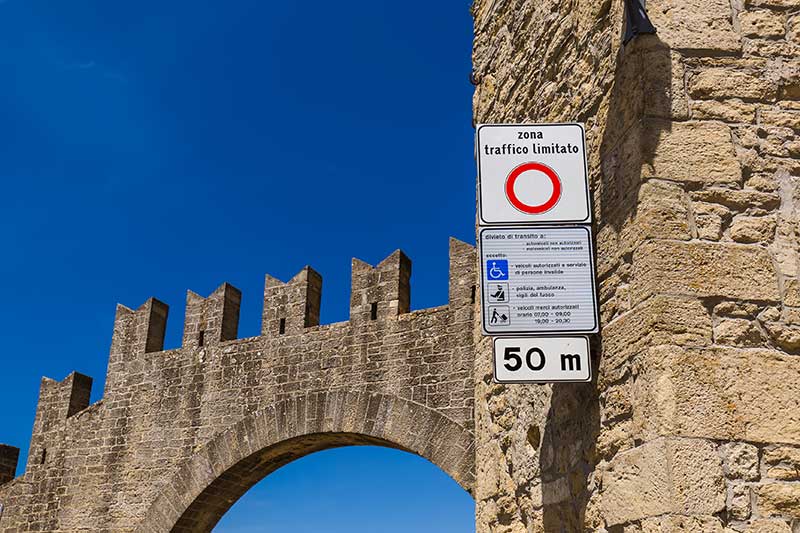
Be aware of the ZTL, areas with limited traffic where cars are not allowed: most historical city centers are like that © Lornet | Dreamstime.com
Beware the Unexpected
Whizzing down the Autostrada in your shiny rented Ferrari (or Panda) is an easy set up for going full throttle to race the Lamborghini that left you in its dust. However, with the plethora of automated speed cameras, that momentary thrill will catch up with you by way of an unpleasant fine. Known as “Autovelox,” fixed speed cameras never sleep. The newer, savvier version called TUTOR SISTEMA is even more refined. A photo is taken at point A, then again at point B with average speed calculated to show how egregious your crime was.
Even if high speed driving is not your thing, driving in any size town or village comes sprinkled with unexpected hazards. The most notorious, in my opinion, is that simple white sign with a red circle: the Zona Traffico Limitato (ZTL). Placed amongst what often seems to be 20 other signs, the ZTL has one meaning for a non-native driver: DO NOT ENTER! Typically found at the beginning of pedestrian zones, historic centers, or neighborhoods, most ZTL’s are accompanied by a camera that will assuredly capture your mistake. It will take months before the beautifully embossed envelope from Italy arrives…with a massive fine inside. Been there, done that.
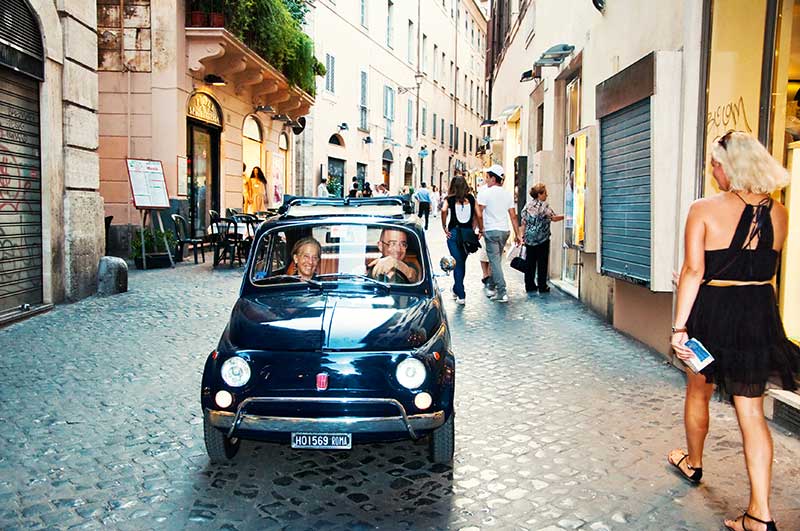
Once you’ve seen the big city sites, it’s time to visit the rental car office © Lornet | Dreamstime.com
Roundabouts are another possibly unexpected experience for the visiting driver. Traffic lights are rare, and it’s crucial to be aware of roundabout rules: those entering yield (but jump in decisively!), swing to the far outer lane if departing at the first exit, be wary of tourists like yourself that might not know these rules. Most roundabouts are accompanied by a jillion or so directional sign to every hamlet within 20 km., but no problem – just drive in circles until you finally spy the one you need!
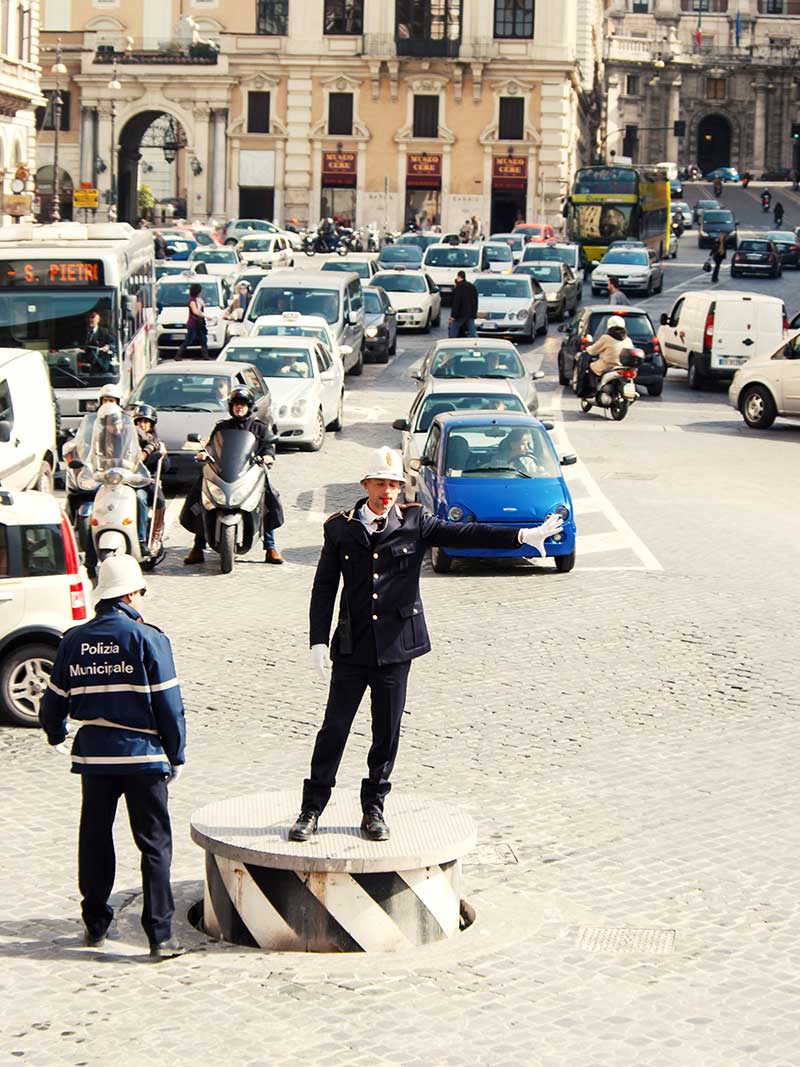
Il vigile urbano: controlling traffic with flair © Elvira Kolomiytseva | Dreamstime.com
Inevitably the need to fill the tank will arise. The majority of stations are manned (Servizio); very nice if you’re feeling unsure…or the one pump is sitting inches away from the road. Initial impressions invoke thoughts like “Cheap gas!”; however, that 1.50 means per litre, equating to an average 6.00 USD per gallon. Save a little and park in front of pumps marked “Fai da Te” – self serve. If the station is open, simply pay the attendant. If closed (think Sundays, holidays, occasional strikes), a handy machine will take your cash (rarely a credit card) for an exact amount – and they’ll keep the change if you over-estimate. Be mindful, however, of whether the car takes unleaded (senza piombo) or diesel (gasolio) in order to avoid a very costly mistake.
Travel comes with challenges, even frustrations, and that’s certainly applicable when choosing to drive in Italy. Of course, there are many more considerations than those addressed here, but the payoff is quantifiably positive. Experiences of a lifetime await…Andiamo!
Noleggia un’auto in Italia, hanno detto. Sarà divertente, hanno detto. E avevano ragione! Beh, in gran parte …
Noleggiare un’auto è abbastanza facile. È tutto ciò che viene dopo che può offrire abbastanza materiale per una buona sit com! Rido ancora all’espressione di orrore sui volti degli amici mentre rispondo con entusiasmo “Sì!!” quando mi si chiede se guido in Italia. Dopotutto, con un cambio alla mano (quelli automatici sono difficili da trovare) e un pieno di benzina sono il biglietto per una deliziosa libertà alla scoperta di tutto ciò che attende lungo una tortuosa strada di campagna italiana. Tuttavia, qualunque potenziale Mario Andretti sarà grato di avere un po’ di informazioni pre-viaggio prima di schiacciare l’acceleratore.
Treno o auto?
Ci sono un certo numero di cose che l’Italia fa bene, e il trasporto pubblico è fra essi. Treni e autobus possono facilmente portare a quasi tutte le principali destinazioni e le città di grandi dimensioni. Siate gentili con voi stessi – usateli! Noleggiare un’auto con l’idea di fare un piccolo giro turistico “da soli” a Roma o Milano o Napoli o anche a Firenze non è una buona idea. Mai. Un amico toscano ha provato a convincermi in merito alcuni anni fa, e dopo aver provato a navigare a Firenze – da sola – senza GPS – so di cosa sto parlando.
Una volta che avete visto i siti delle grandi città, è tempo di far visita all’ufficio delle auto a noleggio. Il mondo da cartolina fatto di piccoli villaggi, aziende vinicole, centri storici e numerosi altri siti degni di nota diventa vostro! La maggior parte delle auto a noleggio sono ora dotate di GPS, rendendo facile viaggiare sulle strade secondarie, ma raccomando di tenere a portata di mano una mappa vecchio stile. Durante un viaggio, la voce cadenzata di un GPS italiano continuava a insistere sul fatto che dovessimo scendere una scala con l’auto in Sicilia. Probabilmente non una grande idea. Sono stata invitata ad oltrepassare il cancello di un contadino più di una volta. A parte questo, una delle più grandi gioie vissute da autista in Italia è stata perdersi. Così spesso presenta il regalo memorabile di un’esperienza meravigliosamente inaspettata!
Strade italiane
La Germania ha la sua Autobahn, Daytona ha la sua 500, e l’Italia ha la sua Autostrada. Queste importanti autostrade a sei corsie collegano da nord a sud, da est a ovest attraverso un sistema (per lo più) ben mantenuto di strade a pedaggio. Lasciatevi alle spalle la vostra sensibilità, abbiate presa d’acciaio sul volante e guidate con l’impegno di un matrimonio lungo 50 anni – e andrete benissimo!
Le regole di base della strada sono abbastanza semplici: rimanere nella corsia di estrema destra. Passare all’altra se necessario, ma affrettatevi a destra o sulla corsia intermedia senza indugio. E’ un po’ come un manto erboso – la corsia di sinistra è per i piloti italiani esperti che spazzolano via un autovelox come una mosca fastidiosa sulla pasta. Il limite di velocità di 130 km (81 mph) è un semplice suggerimento, come lo sono gli indicatori di corsia dipinti, nè vorrete certo essere di intralcio quando un veloce pilota vi sfreccerà accanto.
Il che mi porta alla “simbologia” che uno potrebbe sperimentare se non si torna nella propria corsia abbastanza velocemente. I piloti italiani sono abili, sicuri di sé e veramente non aggressivi come li si potrebbe percepire. Ma le regole non dette della strada sono solide e non hanno paura di ricordarvelo. I fari lampeggianti equivalgono a spostarsi….ORA. Guidare appiccicati a un paraurti tanto da poter contare le otturazioni nei denti del guidatore significa lo stesso. E quei gesti con le mani? Non c’è bisogno di spiegazioni.
Le “strade secondarie” sono ciò che la maggior parte di noi considererebbe il percorso panoramico – piccoli e tortuosi passaggi a doppio senso di marcia che serpeggiano attraverso paesaggi sicuramente fiabeschi. Queste strade vanno bene ogni volta che la spericolata Autostrada vi indicherà di raggiungerne una! Non fatevi distrarre troppo dalla bellezza, però, perché il soggiorno nella propria corsia è anche archiviato sotto “suggestioN”. E’ un’esperienza abbastanza comune (e choccante) girare alla curva successiva e trovare una Fiat che arriva a tutta velocità….nella propria corsia.
Attenti alle sorprese
Percorrere l’autostrada nella vostra lucida Ferrari a noleggio (o Panda) è una situazione facile per andare a tutto gas e competere con la Lamborghini che vi ha lasciato nella sua polvere. Tuttavia, con la pletora di autovelox automatizzati, quel brivido momentaneo vi raggiungerà con una multa sgradevole. Conosciuto come “Autovelox”, la telecamera fissa per la misurazione della velocità non dorme mai. La versione più nuova e più saggia denominata SISTEMA TUTOR è ancora più raffinata. Una foto viene scattata al punto A, poi di nuovo al punto B con una velocità media calcolata per mostrare quanto sia stato grave il vostro crimine.
Anche se la guida ad alta velocità non fa per voi, guidare in città o paese di qualsiasi dimensione è cosparso di pericoli inaspettati. Il più noto, a mio avviso, è quel semplice cartello bianco con un cerchio rosso: la Zona a Traffico Limitato (ZTL). Collocato tra quelli che spesso sembrano essere altri 20 segnali, la ZTL ha solo un significato per un guidatore non autoctono: NON ENTRARE! Si trova tipicamente all’inizio delle zone pedonali, dei centri storici o dei quartieri, la maggior parte delle ZTL è accompagnata da una telecamera che catturerà sicuramente il vostro errore. Ci vorranno mesi prima che arrivi la busta magnificamente goffrata dall’Italia … con una multa enorme dentro. Ci sono entrata, fatto.
Le rotatorie sono un’altra esperienza forse inaspettata per il conducente in visita. I semafori sono rari, ed è fondamentale essere consapevoli delle regole della rotatoria: quelli che entrano (ma entrateci in modo deciso!), tendono verso la corsia esterna se escono alla prima uscita, diffidate dei turisti come voi che potrebbero non conoscere queste regole. La maggior parte delle rotonde è accompagnata da una trentina di cartelli direzionali per ogni frazione entro i 20 km. Ma nessun problema: basta guidare in cerchio fino a quando troverete quello che vi serve!
Inevitabilmente sorgerà la necessità di riempire il serbatoio. La maggior parte delle stazioni hanno personale (Servizio); molto bello se vi sentite insicuri … o l’unica pompa è a pochi centimetri dalla strada. Le impressioni iniziali invocano pensieri come “carburante economico!”; tuttavia, quel 1,50 significa a litro ed è pari a una media di 6,00 USD a gallone. Per risparmiare un po’ parcheggiate di fronte alle pompe contrassegnate “Fai da Te – self-service”. Se la stazione è aperta, è sufficiente pagare l’addetto. Se chiusa (in caso di domeniche, festività, scioperi occasionali), una macchina a portata di mano prenderà i contanti (raramente una carta di credito) per l’importo esatto – e si terrà il di più se supererete le stime. Prestate attenzione, tuttavia, se l’auto va alimentata con benzina senza piombo (senza piombo) o diesel (gasolio) al fine di evitare un errore molto costoso.
Il viaggio porta sfide, anche frustrazioni, e questo è certamente possibile quando si sceglie di guidare in Italia. Naturalmente, ci sono molte più considerazioni di quelle qui affrontate, ma la ricompensa è sostanzialmente positiva. Esperienze di una vita attendono … Andiamo!






